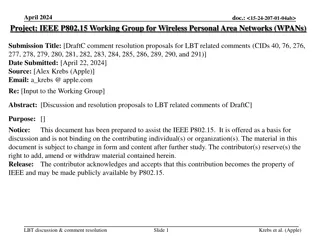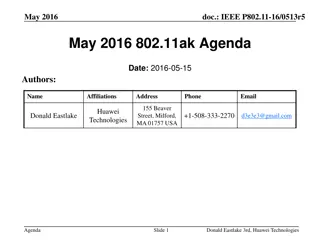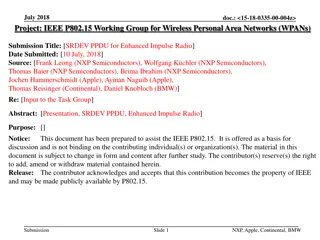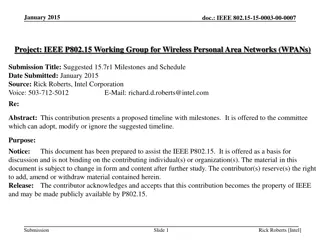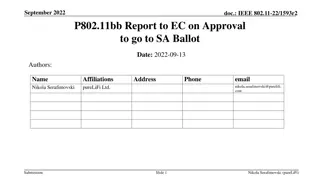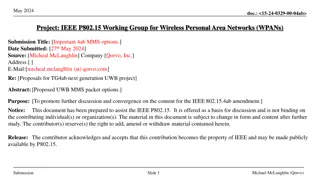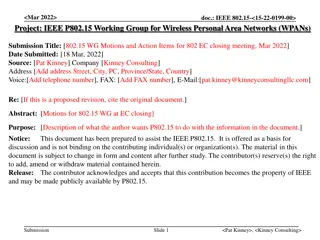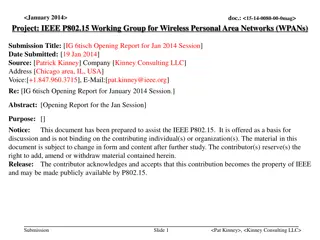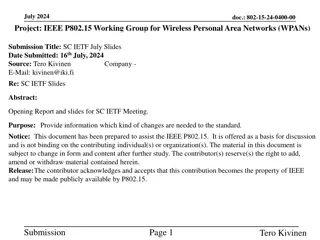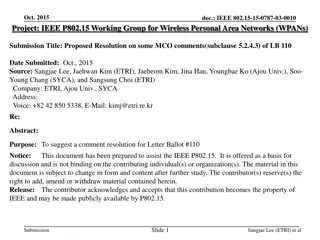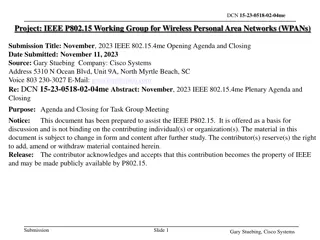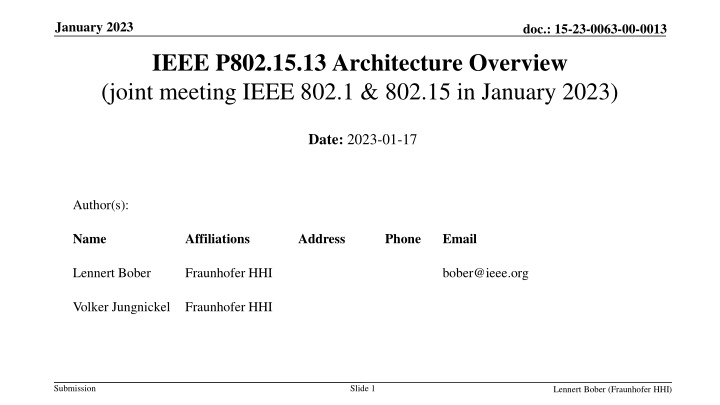
IEEE P802.15.13 Architecture Overview at Joint IEEE Meeting
Explore the architecture overview of IEEE P802.15.13 presented by Lennert Bober at a joint meeting of IEEE 802.1 and 802.15 in January 2023. The presentation covers network architecture, device architecture, addressing, and MD-SAP interface details. Learn about the use of IEEE Std 802 architecture in P802.15.13, network topologies, device layers, MAC addressing, and more.
Download Presentation

Please find below an Image/Link to download the presentation.
The content on the website is provided AS IS for your information and personal use only. It may not be sold, licensed, or shared on other websites without obtaining consent from the author. If you encounter any issues during the download, it is possible that the publisher has removed the file from their server.
You are allowed to download the files provided on this website for personal or commercial use, subject to the condition that they are used lawfully. All files are the property of their respective owners.
The content on the website is provided AS IS for your information and personal use only. It may not be sold, licensed, or shared on other websites without obtaining consent from the author.
E N D
Presentation Transcript
January 2023 doc.: 15-23-0063-00-0013 IEEE P802.15.13 Architecture Overview (joint meeting IEEE 802.1 & 802.15 in January 2023) Date: 2023-01-17 Author(s): Name Affiliations Address Phone Email Lennert Bober Fraunhofer HHI bober@ieee.org Volker Jungnickel Fraunhofer HHI Submission Slide 1 Lennert Bober (Fraunhofer HHI)
January 2023 doc.: 15-23-0063-00-0013 Abstract This presentation summarizes IEEE P802.15.13 s use of the IEEE Std 802 architecture. Extracted text is from P802.15.13-D10 [1]. Submission Slide 2 Lennert Bober (Fraunhofer HHI)
January 2023 doc.: 15-23-0063-00-0013 Network Architecture and Topology Coordinator and Member devices Coordinators maintain networks ( OWPANs ) Coordinator transfers between members and external networks Logical star topology with some subtypes Distributed MIMO topology Broadcast topology Relay topology Submission Slide 3 Lennert Bober (Fraunhofer HHI)
January 2023 doc.: 15-23-0063-00-0013 Device Architecture: (Sub)layers and Interfaces IEEE P802.15.13-D10 5.5.1: The IEEE Std 802.15.13 device architecture is defined in terms of layers. [ ] Layers make use of service access points (SAPs) based on primitives, as described in the subclause 5.8, "Concept of primitives", in IEEE Std 802.15.4 -2020. Coordinators and Member devices have the same architecture. Next higher protocol layer uses services provided by MD-SAP. Device Management Entity (DME) [out of scope] manages devices. MAC sublayer controls transmissions via the PHY layer, interface is internal. Light-based transmission via optical frontends (OFE) allows data exchange with deterministic properties. Submission Slide 4 Lennert Bober (Fraunhofer HHI)
January 2023 doc.: 15-23-0063-00-0013 Addressing IEEE P802.15.13-D10 6.2.2: Each device conforming to this standard shall have a MAC address that is a EUI-48 as specified by IEEE Std 802 The MAC address shall be sent in the canonical format defined in IEEE Std 802 The MAC address value FF-FF-FF-FF-FF-FF shall be used as the broadcast address. MSDUs that have a destination address that has the multicast bit set in the MD-DATA.request shall be treated as if the destination address was the broadcast address. Each device has an AIDassigned as part of the association process. 16 bit, purely internal Association ID Each OWPAN is identified through its OWPAN ID. The OWPAN ID corresponds to the MAC address of the coordinator. Submission Slide 5 Lennert Bober (Fraunhofer HHI)
January 2023 doc.: 15-23-0063-00-0013 MD-SAP Interface with higher layers for transmission and reception of MSDUs towards peer devices. IEEE P802.15.13-D10 8.2.1: MSDUs shall be in EtherType protocol discrimination format, described in IEEE Std 802. Thus, the two octet wide EtherType shall be prepended to the MSDU in big endian byte order. EtherType Protocol Discrimination (EPD) is always used. IEEE P802.15.13-D10 8.2.2: Provides IEEE Std 802.1AC MAC service Receives Priority 0 8 Submission Slide 6 Lennert Bober (Fraunhofer HHI)
January 2023 doc.: 15-23-0063-00-0013 MAC Frames for Frame-based transmission IEEE P802.15.13-D10 7.1.1: This standard defines a single general MAC frame format, also referred to as MPDU. MPDU includes MAC addresses of IEEE 802.15.13 receiver and transmitter Data frames contain one or multiple MSDUs and their source and destination MAC addresses in the Payload field MSDU Aggregation (6.7.3) and Fragmentation (6.6) for efficient data transfer and support of large frames. No QoS information in MPDU header Submission Slide 7 Lennert Bober (Fraunhofer HHI)
January 2023 doc.: 15-23-0063-00-0013 MLME IEEE P802.15.13-D10 8.3.1: The MLME-SAP supports the management and usage of a device s MLME functionality through the DME. The primitives supported by the MLME-SAP are given in Table 15. MLME interface is kept minimal IEEE P802.15.13-D10 8.4 MAC PIB attributes : PIB attributes determine device behavior; settable via MLME-SET No managed objects registered IEEE P802.15.13-D10 8.6 Device capabilities : Devices have capabilities for negotiation of features used while associated with the network Submission Slide 8 Lennert Bober (Fraunhofer HHI)
January 2023 doc.: 15-23-0063-00-0013 Security Encryption, authentication, cryptographic integrity protection are not part of IEEE P802.15.13-D10 Left for future addition; potential use of other IEEE standards 802.1X? 802.1AE? 802.1AR? 802.15.9? Submission Slide 9 Lennert Bober (Fraunhofer HHI)
January 2023 doc.: 15-23-0063-00-0013 MAC and PHY services MAC with scheduled and polled medium access Deterministic access MSDUs potentially delayed while waiting for medium access Transmit scheduling is implementation-specific Frame-based PHYs with On-Off-Keying & OFDM PHYs determine maximum frame size: 2044 octets for the PM-PHY 1 683 456 octets for the HB-PHY Submission Slide 10 Lennert Bober (Fraunhofer HHI)
January 2023 doc.: 15-23-0063-00-0013 Summary IEEE P802.15.13-D10 architecture orientates itself towards IEEE 802.1. Goal: integrate with existing IEEE Std 802 LANs. Future plans: support real-time networking and relevant TSN standards. Goal: coexist with RF as light-based infrastructure network for medium diversity and offloading together. Draft D10 is currently with RevCom Implementation to be evaluated Possibly new functionality / fixes through amendments or revisions Extended overview over latest draft in [2] Submission Slide 11 Lennert Bober (Fraunhofer HHI)
January 2023 doc.: 15-23-0063-00-0013 References [1] IEEE P802.15.13-D10, see https://ieeexplore.ieee.org/document/9963940 [2] K. L. Bober et al., The IEEE 802.15.13 Standard for Optical Wireless Communications in Industry 4.0. https://ieeexplore.ieee.org/document/9968724 Submission Slide 12 Lennert Bober (Fraunhofer HHI)


